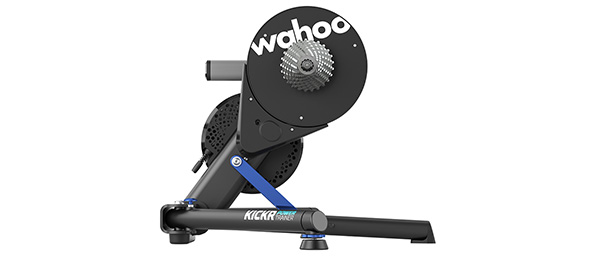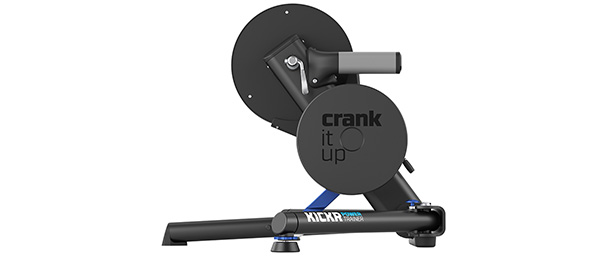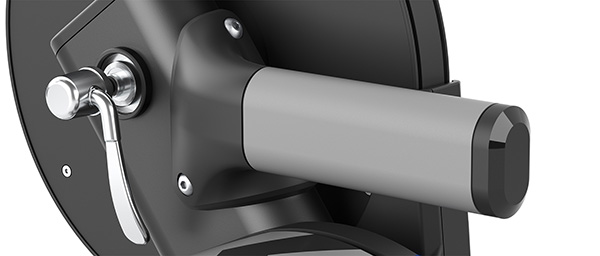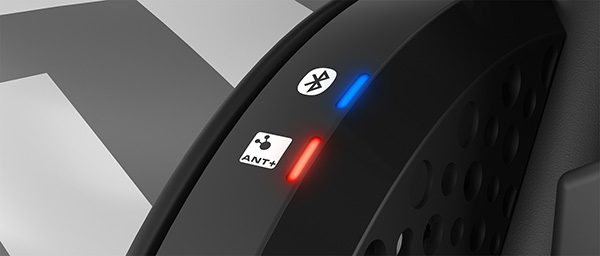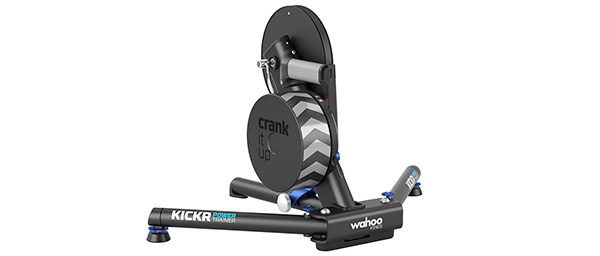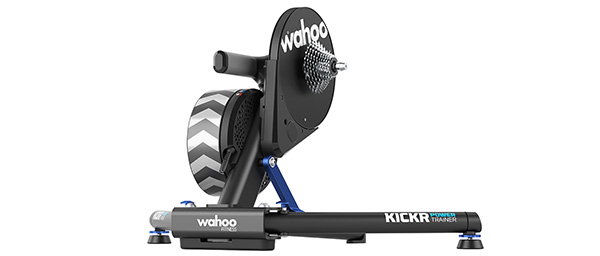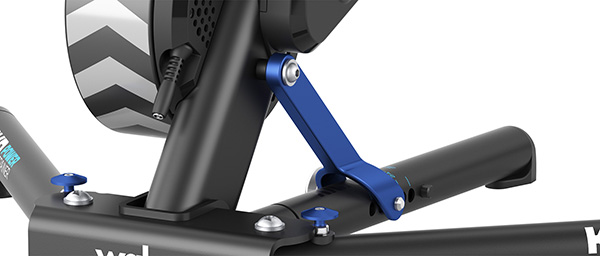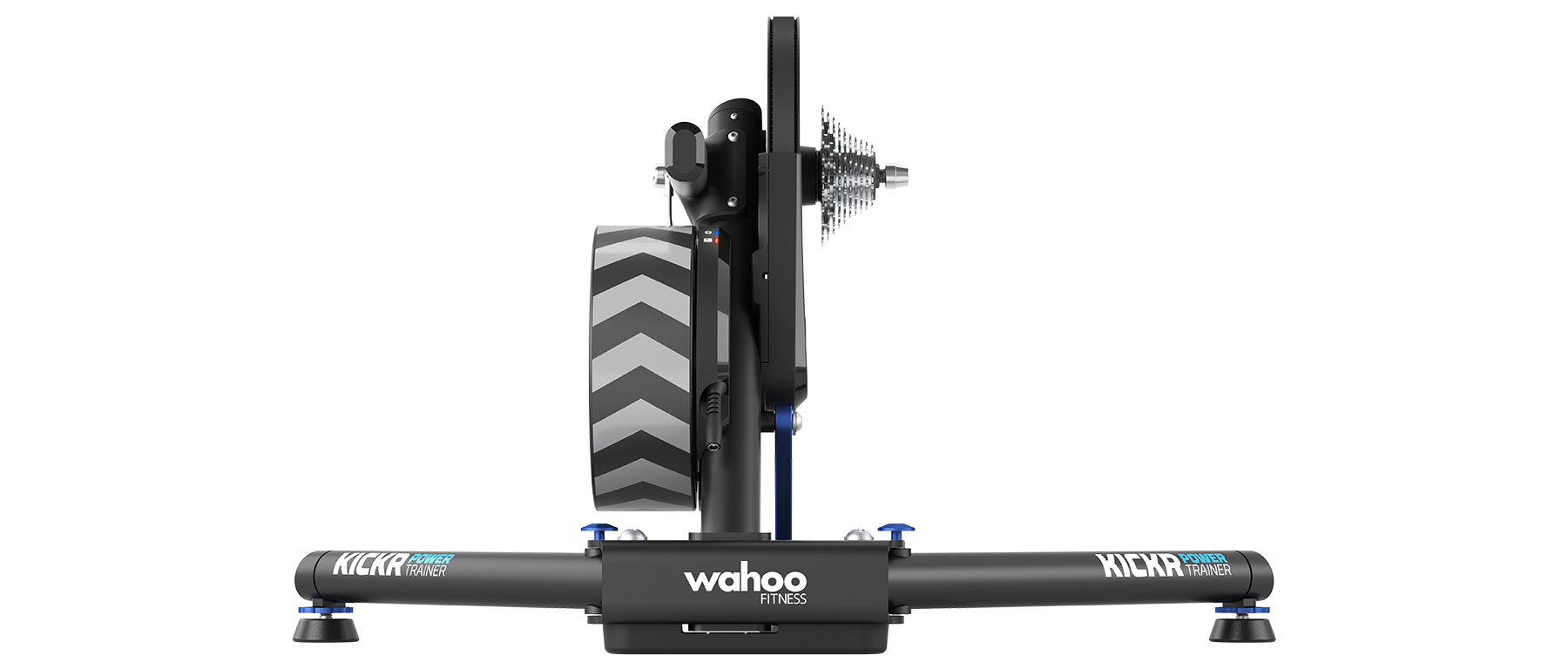Description


Wahoo just keeps pushing forward. The Fall of 2017 brings an updated KICKR Power Trainer, built for an optimal training season with the KICKR CLIMB unit (available in 2018), which will change the way you think of indoor training. Also new for 2017 is added and included thru-axle capability up to 12/148mm.
Indoor training can be a slog, especially in regions where riding outdoors in the winter just is't feasible. Just as the whole technical side of cycling has exploded over the last few years, indoor trainers have raised the bar and expectations as to what cyclists both put in, and get out of, indoor training. The buzzwords are connectivity, third party app and power meter support, control via external device, and increased performance and accuracy. When the Wahoo KICKR was released it changed the game for wheel-off, direct drive trainers by adding Smart capability via a Bluetooth interface with your smartphone, app use, and support. The pace of change is incredibly fast within the tech world, and Wahoo separated themselves from many traditional, blunt object trainer makers with excellent customer support and interaction, rapid firmware upgrades, and a dedication to building both hardware and software worlds at a faster rate, with increasingly useful and usable integration. Don't discount that last aspect. Now instead of just working through updates, Wahoo has updated the KICKR Power Trainer, as a new starting point largely based on customer feedback, along with rising challenges from competitors and a desire to be great; with better features, increased connectivity and control, and a real focus on improving the physical deliverables of the training experience- higher power capability, increased maximum grade, noise reduction and the ole' reliable trainer conundrum- a better road feel and more realistic experience that CLIMB will only enhance.
The physical improvements are straightforward and simple to value. First, given it's folding and easily stored design, the latest carry handle was conceived. The new handle has a comfort grip and the trainer weight balances, so it is easier to control and move around. The second physical change was a redesign of the actual belt and flywheel interface that drives the unit. This was to address concerns about not only on the overall decibel level of the trainer, but a high pitched noise signal that some people were particularly sensitive to. That noise is now gone, and Wahoo claims the overall noise output at 61 decibels, which make it the quietest direct drive flywheel-type trainer. The third physical change was the removal of the strain gauge and the use of the internal braking system to both measure and manage the power curve.
Accuracy of the KICKR is rated at +/- 2%, which is what the original unit listed, but there seemed to be some production inconsistency. Simplifying the system appears to have corrected that. The same change also improved the reactive power curve, so if you create a huge power jump, through an interval or sprint the unit will react faster, more like being on the road. The reverse process also holds true, with the descending curve. The third change, specific to the use with KICKR CLIMB is that the hub and rear dropout can rotate freely as the CLIMB unit moves up and down, eliminating any possibility of frame damage. The fourth change was creating more room for the disc brake when CLIMB is moves into a descent angle. The final physical change was the placement of two LED indicators on the rear lower housing which reflect Bluetooth and/or ANT+ connectivity, making pairing and awareness of an active pairing clear to the user. This was a change truly driven by user feedback, and welcome one.
Wahoo makes the claim that no trainer supports more apps, from virtual structured rides and workouts from providers like Zwift, TrainerRoad, KinoMap, BKool, Wahoo Fitness App, and much more. Connectivity is covered with Bluetooth Smart, ANT+, and ANT+ FE-C. This last was a firmware addition to the 1st gen unit, and is much coveted because it allows the trainer to be manually or automatically controlled from any FE-C enabled device or application, most notably via most of the key Garmin GPS/bike computer head units. Wahoo includes their cadence sensor, and now when using it, the New Kickr measures and transmits speed, distance, power and cadence to your app or head unit. Wahoo also has third party support for applicable power meters and popular training apps.
Wahoo was rightly praised for the construction, foldability, and portability of the KICKR, and the stout steel construction remains. The unit is incredibly easy to manage, and the use of color allows for quick identification of components for quick breakdown and set-up. The KICKR maintains the requirement for AC power, so while it may be a great indoor training product, unless your team bus is pushing out the required amperage and voltage, it is unlikely you will be using it to warm-up at events. The direct drive design comes with a removable 11-speed Shimano-type cassette and you can use spacers for SRAM/ Shimano 8, 9, 10 speed. The KICKR is 130, 135mm QR compatible and offers 12/142 and 12/148mm thru-axle conversion. There is a rider weight limit of 250lbs, and a front wheel block is not required to level your bike, though some may choose to limit the front end from turning if they aren't using the KICKR CLIMB.
Wahoo has quickly built their reputation on solid hardware, flexible firmware, connectivity, and third party app support, to go along with the responsive customer service and development. Wireless software updates make your life easy. We feel the KICKR has evolved, with Wahoo listening to questions and feedback from internal testing and the cycling public. This updated version is really the third iteration, with regular and impressive firmware updates along the way. That alone, never mind the strong commitment to making the KICKR platform the most accessible option for third party devices, apps, and controls, make Wahoo a favorite of the Excel staff and our customers. If you have any questions about making an investment in yourself as a cyclist or triathlete, feel free to give us a call at (800)627-6664 and we can talk you through it.
Return to TopFeatures
- Updated 2nd gen KICKR direct drive, wheel off-trainer, with real improvements
- Designed to be fully compatible with KICK'R CLIMB system
- Rated to 2000 max watts, capable of simulating 20% grade
- Reduced overall sound to 61 decibels, eliminated whine with belt design change
- Connectivity for Bluetooth Smart and ANT+ via dedicated LED indicators
- Improved overall accuracy to 2%, improved power curve for faster response
- New ergonomic carry handle centers and balances unit for greater control
- Foladable, wide stance trainer is very stable, easy to use, and stored
- Requires AC power: 100-240V~1.5A 50-60 Hz
- Electromagnetic resistance with 12.5lb flywheel
- Third party power meter and training app control
- Connectivity: Bluetooth Smart, ANT+, ANT+ FE-C enable device control
- Wireless software updates to unit
- No trainer supports more Apps, including Wahoo Fitness, Zwift, TrainerRoad, etc
- Wheel Sizes/Dropouts: 24" / 650c / 26" / 27.5"/ 29" / 130mm, 135mm QR, 12/142 &12/148mm TA
- Steel frame material, Gates Carbon Belt, easy to identify and use fitments
- Dimensions: Open 21" x 28" (54 cm x 71 cm), Closed 21" x 9" (54 cm x 23 cm)
- In box: AC Adapter, 11-spd Shimano cassette, Wahoo RPM2 Cadence Sensor, Skewer, hub adapters Weight: 47lbs
